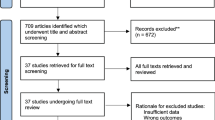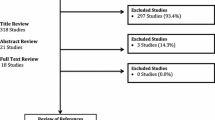Abstract
Introduction
The purpose of this study was to systematically review the literature to understand the contemporary outcomes for patients with joint laxity managed with hip arthroscopy.
Materials and methods
A search was performed utilizing the Preferred Reporting Items for Systematic Reviews and Meta-Analysis Statement guidelines. All literature related to joint laxity in hip arthroscopy patients was identified. Inclusion criteria consisted of patient-reported outcomes and Beighton and Horan Joint Mobility Index scoring. Study quality was assessed using the Methodological Index of Non-Randomized Studies criteria.
Results
Seven articles were identified, including 412 patients (416 hips). Patients were predominantly female (range 83–100%). Mean patient age ranged from 13–69 years. Five studies consisting of 370 hips reported a range of 75 to 100% undergoing labral repair, 0 to 13% labral debridement, 0 to 7% labral reconstruction, 43 to 100% capsular closure, 94 to 99% femoroplasty, 3 to 80% rim resection, and 9 to 50% subspine decompression for surgical management. Post-operative follow-up range was 6–99 months. The mean range of improvement in Hip Outcomes Score Activities of Daily Living, Hip Outcomes Score-Sports Subscale, modified Harris Hip Score, Visual Analog Scale, and 12 item Short Form Health Survey were 17.6–31.3, 31.3–35.1, 22.5–53.8, − 2.79–8, and 12.4–16.9 respectively.
Conclusion
Generalized ligamentous laxity patients managed with hip arthroscopy were predominantly young women. At short-term follow-up, mean patient-reported outcomes were positive, with improvement postoperatively in activities of daily living, sports, and quality of life.

Similar content being viewed by others
Data availability
The datasets generated and analyzed during the current study are available in anonymized format from the corresponding author upon reasonable request.
References
Russek LN, Errico DM (2016) Prevalence, injury rate and symptom frequency in generalized joint laxity and joint hypermobility syndrome in a “healthy” college population. Clin Rheumatol 35:1029–1039. https://doi.org/10.1007/s10067-015-2951-9
Atwell K, Michael W, Dubey J et al (2021) Diagnosis and management of hypermobility spectrum disorders in primary care. J Am Board Fam Med 34:838–848. https://doi.org/10.3122/JABFM.2021.04.200374
Armstrong R, Greig DM (2018) The Beighton score as a predictor of Brighton criteria in sport and dance. Phys Ther Sport 32:145–154. https://doi.org/10.1016/J.PTSP.2018.04.016
Castori M, Morlino S, Grammatico P (2014) Towards a re-thinking of the clinical significance of generalized joint hypermobility, joint hypermobiity syndrome, and Ehlers–Danlos syndrome, hypermobility type. Am J Med Genet A 164A:588–590. https://doi.org/10.1002/AJMG.A.36437
Guier C, Shi G, Ledford C et al (2020) Primary total hip arthroplasty in patients with Ehlers–Danlos syndrome: a retrospective matched-cohort study. Arthroplast Today 6:386–389. https://doi.org/10.1016/J.ARTD.2020.05.006
Tibbo ME, Wyles CC, Houdek MT, Wilke BK (2019) Outcomes of primary total knee arthroplasty in patients with Ehlers–Danlos syndromes. J Arthroplasty 34:315–318. https://doi.org/10.1016/j.arth.2018.09.079
Moore HG, Burroughs PJ, Rubin LE et al (2022) Patients with Ehlers–Danlos syndromes experience higher rates of prosthetic dislocation after total hip arthroplasty and worse implant survival at 5 years. J Am Acad Orthop Surg 30:177–183. https://doi.org/10.5435/JAAOS-D-21-00347
Domb BG, Stake CE, Lindner D et al (2013) Arthroscopic capsular plication and labral preservation in borderline hip dysplasia two-year clinical outcomes of a surgical approach to a challenging problem. Am J Sports Med 41:2591–2598. https://doi.org/10.1177/0363546513499154
Domb BG, Philippon MJ, Giordano BD (2013) Arthroscopic capsulotomy, capsular repair, and capsular plication of the hip: relation to atraumatic instability. Arthroscopy 29:162–173. https://doi.org/10.1016/j.arthro.2012.04.057
Larson CM, Stone RM (2013) Current concepts and trends for operative treatment of FAI: hip arthroscopy. Curr Rev Musculoskelet Med. https://doi.org/10.1007/s12178-013-9170-2
Naal FD, Hatzung G, Müller A (2014) Validation of a self-reported Beighton score to assess hypermobility in patients with femoroacetabular impingement. Int Orthop 38:2245–2250. https://doi.org/10.1007/s00264-014-2424-9
Dumont GD (2016) Hip instability: current concepts and treatment options. Clin Sports Med 35:435–447. https://doi.org/10.1016/J.CSM.2016.02.008
Ortiz-Declet V, Mu B, Chen AW et al (2018) Should the capsule be repaired or plicated after hip arthroscopy for labral tears associated with femoroacetabular impingement or instability? A systematic review. Arthroscopy 34:303–318. https://doi.org/10.1016/J.ARTHRO.2017.06.030
Abd Razak HR, Ali N, Howe T (2014) Generalized ligamentous laxity may be a predisposing factor for musculoskeletal injuries. J Sci Med Sport 17:474–478. https://doi.org/10.1016/J.JSAMS.2013.11.001
Zeng X, Zhang Y, Kwong JSW et al (2015) The methodological quality assessment tools for preclinical and clinical studies, systematic review and meta-analysis, and clinical practice guideline: a systematic review. J Evid Based Med 8:2–10. https://doi.org/10.1111/JEBM.12141
Larson CM, McGaver RS, Collette NR et al (2019) Arthroscopic surgery for femoroacetabular impingement in skeletally immature athletes: radiographic and clinical analysis. Arthroscopy 35:1819–1825. https://doi.org/10.1016/j.arthro.2019.01.029
Kemp JL, Collins NJ, Roos EM, Crossley KM (2013) Psychometric properties of patient-reported outcome measures for hip arthroscopic surgery. Am J Sports Med 41:2065–2073. https://doi.org/10.1177/0363546513494173
Chahal J, Van Thiel GS, Mather RC et al (2015) The patient acceptable symptomatic state for the modified Harris hip score and hip outcome score among patients undergoing surgical treatment for femoroacetabular impingement. Am J Sports Med 43:1844–1849. https://doi.org/10.1177/0363546515587739
Cote MP, Lubowitz JH, Rossi MJ, Brand JC (2018) Reviews pooling heterogeneous, low-evidence, high-bias data result in incorrect conclusions: but heterogeneity is an opportunity to explore. Arthroscopy 34:3126–3128. https://doi.org/10.1016/j.arthro.2018.10.005
Hammarstedt J, Redmond J, Gupta A, Domb B (2015) Arthroscopic ligamentum teres reconstruction of the hip in Ehlers–Danlos syndrome: a case study. Hip Int 25:286–291
Larson C, Stone R, Grossi E et al (2015) Ehlers–Danlos syndrome: arthroscopic management for extreme soft-tissue hip instability. Arthroscopy 31:2287–2294. https://doi.org/10.1016/j.arthro.2015.06.005
Ukwuani G, Waterman B, Nwachukwu B et al (2019) Return to dance and predictors of outcome after hip arthroscopy for femoroacetabular impingement syndrome. Arthroscopy 35:1101-1108.e3. https://doi.org/10.1016/j.arthro.2018.10.121
Saadat AA, Lall AC, Battaglia MR et al (2019) Prevalence of generalized ligamentous laxity in patients undergoing hip arthroscopy: a prospective study of patients’ clinical presentation, physical examination, intraoperative findings, and surgical procedures. Am J Sports Med 47:885–893. https://doi.org/10.1177/0363546518825246
Stone AV, Mehta N, Beck EC et al (2019) Comparable patient-reported outcomes in females with or without joint hypermobility after hip arthroscopy and capsular plication for femoroacetabular impingement syndrome. J Hip Preserv Surg 6:33–40. https://doi.org/10.1093/jhps/hnz004
Pontiff M, Ithurburn MP, Ellis T, et al (2016) Function and quality of life in women with and without generalized joint laxity undergoing hip arthroscopy for. 11:378–387
Maldonado DR, Chen JW, Yelton MJ et al (2020) Achieving successful outcomes of hip arthroscopy in the setting of generalized ligamentous laxity with labral preservation and appropriate capsular management: a propensity matched controlled study. Am J Sports Med 48:1625–1635. https://doi.org/10.1177/0363546520914604
Demmler JC, Atkinson MD, Reinhold EJ et al (2019) Diagnosed prevalence of Ehlers–Danlos syndrome and hypermobility spectrum disorder in Wales, UK: a national electronic cohort study and case-control comparison. BMJ Open. https://doi.org/10.1136/bmjopen-2019-031365
Maruyama S, Sekine C, Shagawa M et al (2022) Menstrual cycle changes joint laxity in females-differences between eumenorrhea and oligomenorrhea. J Clin Med. https://doi.org/10.3390/JCM11113222
Cherni Y, Desseauve D, Decatoire A et al (2019) Evaluation of ligament laxity during pregnancy. J Gynecol Obstet Hum Reprod 48:351–357. https://doi.org/10.1016/J.JOGOH.2019.02.009
Muldoon M, Gosey G, Healey R, Santore R (2016) Hypermobility: a key factor in hip dysplasia. A prospective evaluation of 266 patients. J Hip Preserv Surg 1:2
Katz JN, Arant KR, Loeser RF (2021) Diagnosis and treatment of hip and knee osteoarthritis: a review. JAMA 325:568–578. https://doi.org/10.1001/JAMA.2020.22171
Kalisvaart MM, Safran MR (2015) Microinstability of the hip–it does exist: etiology, diagnosis and treatment. J Hip Preserv Surg 2:123–135. https://doi.org/10.1093/jhps/hnv017
O’Donnell JM, Arora M (2018) A novel and simple classification for ligamentum teres pathology based on joint hypermobility. J Hip Preserv Surg 5:113–118. https://doi.org/10.1093/jhps/hnx039
Devitt BM, Smith BN, Stapf R et al (2017) Generalized joint hypermobility is predictive of hip capsular thickness. Orthop J Sports Med 5:1–7. https://doi.org/10.1177/2325967117701882
Duthon VB, Charbonnier C, Kolo FC et al (2013) Correlation of clinical and magnetic resonance imaging findings in hips of elite female ballet dancers. Arthroscopy 29:411–419. https://doi.org/10.1016/J.ARTHRO.2012.10.012
Mitchell RJ, Gerrie BJ, McCulloch PC et al (2016) Radiographic evidence of hip microinstability in elite ballet. Arthroscopy 32:1038-1044.e1. https://doi.org/10.1016/j.arthro.2015.12.049
Naal FD, Müller A, Varghese VD et al (2017) Outcome of hip impingement surgery: does generalized joint hypermobility matter? Am J Sports Med 45:1309–1314. https://doi.org/10.1177/0363546516688636
Brennan K, Spencer-Smith C, Villar R (2013) The influence of ligamentous laxity on the outcome of hip arthroscopy for femoroacetabular impingement. Arthroscopy 29:e213. https://doi.org/10.1016/j.arthro.2013.09.065
Philippon MJ, Skendze JG, Herzog M et al (2013) Hip arthroscopy for FAI: predictors of patient satisfaction and conversion to total hip arthroplasty 5 to 7 years following arthroscopy. Orthop J Sports Med 1:2013. https://doi.org/10.1177/2325967113S00006
Duplantier NL, McCulloch PC, Nho SJ et al (2016) Hip dislocation or subluxation after hip arthroscopy: a systematic review. Arthroscopy 32:1428–1434. https://doi.org/10.1016/j.arthro.2016.01.056
Sundemo D, Jacobsson MS, Karlsson J et al (2022) Generalized joint hypermobility does not influence 1-year patient satisfaction or functional outcome after ACL reconstruction. Knee Surg Sports Traumatol Arthrosc. https://doi.org/10.1007/S00167-022-07008-0
Harris JD, Slikker W, Gupta AK et al (2013) Routine complete capsular closure during hip arthroscopy. Arthrosc Tech 2:e89–e94. https://doi.org/10.1016/j.eats.2012.11.007
Frank RM, Lee S, Bush-Joseph CA et al (2014) Improved outcomes after hip arthroscopic surgery in patients undergoing t-capsulotomy with complete repair versus partial repair for femoroacetabular impingement: a comparative matched-pair analysis. Am J Sports Med 42:2634–2642. https://doi.org/10.1177/0363546514548017
Acknowledgements
None
Funding
No funding was received for our analysis.
Author information
Authors and Affiliations
Contributions
MAG, LTS, RJB, and AJA were involved in the study concept and design. JTR and AJA were involved in the acquisition of data and analysis of the data. MAG, LTS, RJB, AJA, and AFK were involved in the drafting of the manuscript. All authors read and approved the final manuscript.
Corresponding author
Ethics declarations
Conflict of interest
A.F.K. reports the following disclosures: research support (Signature Orthopedics), paid presenter or speaker (DePuy Synthes and Zimmer Biomet), paid consultant (DePuy Synthes and Zimmer Biomet), stock or stock options (Zimmer Biomet, Johnson & Johnson, and Procter & Gamble), IP royalties (Innomed), and board or committee member (AAOS, AAHKS, and Anterior Hip Foundation M.A.G, L.T.S, R.J.B, A.J.A, and J.T.R have nothing to disclose.
Ethical approval
Our analysis included de-indefitied information from a publicly available dataset and therefore, IRB approval was not required.
Informed consent
Our analysis included de-indefitied information from a publicly available dataset and therefore, patient consent was not required.
Additional information
Publisher's Note
Springer Nature remains neutral with regard to jurisdictional claims in published maps and institutional affiliations.
Rights and permissions
Springer Nature or its licensor (e.g. a society or other partner) holds exclusive rights to this article under a publishing agreement with the author(s) or other rightsholder(s); author self-archiving of the accepted manuscript version of this article is solely governed by the terms of such publishing agreement and applicable law.
About this article
Cite this article
Gaudiani, M.A., Samuel, L.T., Burkhart, R.J. et al. What is the utility of hip arthroscopy in patients with joint laxity? A contemporary systematic review of patient-reported and surgical outcomes. Arch Orthop Trauma Surg 143, 5133–5142 (2023). https://doi.org/10.1007/s00402-022-04737-2
Received:
Accepted:
Published:
Issue Date:
DOI: https://doi.org/10.1007/s00402-022-04737-2




